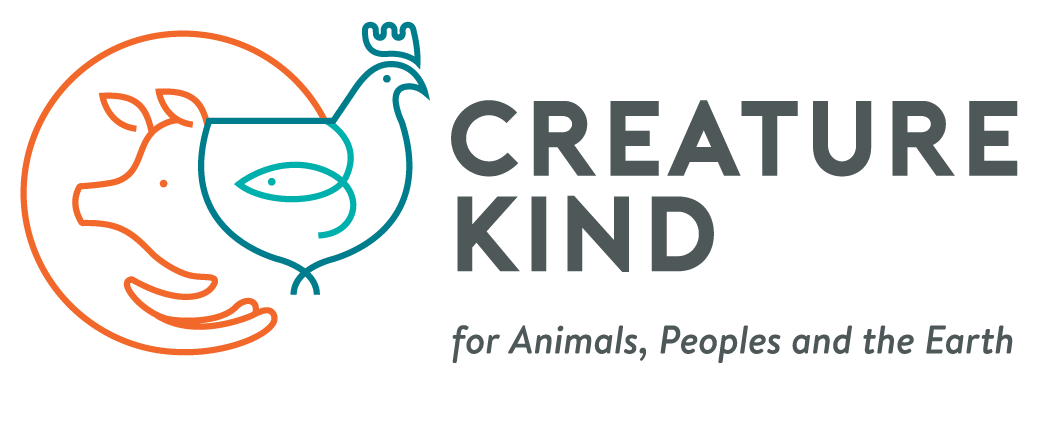As both a Christian and a vegan, something that I think about often is the way in which my faith is compatible with my vegan values. I stopped eating meat at around the same time that I started seminary school, and at the time I did not consider the two things to be connected in any way. However, as I began studying Scripture more in depth, I began to realize that actually, my concern for animals and the environment, which originally caused me to ditch meat, and later on all animal products (including dairy, eggs, honey, leather, fur, etc.), was in fact very much related to my faith in God as Creator and Redeemer.
The question that I’ve been reflecting on and which I would like to discuss is whether or not the Christian Gospel (the “Good News”) has any bearing on animals and the earth. The answer I have come to is that yes, it has absolutely everything to do them as well. This may seem like a bit of a jump to some of my Christian brothers and sisters, many of whom are of the opinion that God actually made animals FOR us to eat (I used to be of this opinion too for most of my life), and that we have some kind of license to use them and use the planet as we see fit since God said that we are to “have dominion” over them (Gen 1:26).
Furthermore, the way that the Gospel has been presented most frequently has been with a very heavy emphasis on “personal salvation” to the extent that we think that it is all about us – US being forgiven by God, US for whom Christ died, US for whom the earth was created, US who will be going to heaven (“Do animals even have even have souls?” some may argue). It’s no wonder many have accused Christianity of being an anthropocentric (human-centered) religion. But while I would agree that Christians can often come across as such, and tend use the Bible to support their anthropocentric views, the Bible itself does not condone such a mentality.
In order to go about answering this question of whether the Gospel is good news for the animals (and the earth) as well as humans, we must start by giving a little bit of background. In the Biblical account, it all begins with God creating “the heavens and the earth” (Gen 1:1). This earth that God created was deemed as “good” (Gen 1:4, 10, 12, 18, 21, 25, 31).
What was this creation like? The first word that comes to my mind when I read the creation account is “abundant.” It was abundantly filled with fruits and vegetation and all kinds of animals. Then God created the man and the woman and God's mandate to them was to “Be fruitful and increase in number; fill the earth and subdue it. Rule over the fish in the sea and the birds in the sky and over every living creature that moves on the ground” (Gen 1:28). This is where some people start getting confused, thinking that this rulership somehow gives them permission to take advantage of and exploit what God has put under their care.
The second word that comes to mind when I think about what the original creation was like is “harmony.” Humans in harmonious relationships with God, with each other, with the animals and with the earth. Indeed, in the original creation, humans did not eat animals, and animals did not eat other animals. Genesis 1:29-30…“Then God said, ‘I give you every seed-bearing plant on the face of the whole earth and every tree that has fruit with seed in it. They will be yours for food. And to all the beasts of the earth and all the birds in the sky and all the creatures that move along the ground – everything that has the breath of life in it [souls?] – I give every green plant for food.’ And it was so.”
So what I see from the Creation account is that the world God created was good, it was perfect, it was harmonious and abundant, there was no harm, no evil, no violence, no death. What happened? This is where the bad news comes in, with sin and disobedience entering the picture, Adam and Eve doing the one thing God told them not to do (eating from one single tree out of the many they were allowed to eat from), wanting to live the way they wanted instead of how God wanted them to. And this is where everything falls apart.
It is at this point in the story that the relationships between God and humans, humans and each other, humans and animals, and finally, humans and the earth were distorted. The man and the woman were now hiding from each other by covering their nakedness that they were never ashamed of before (Gen 3:7). They were also hiding from God in the garden (Gen 3:8). They started playing the blame game for the sin they both committed (Gen 3:12). Now even the earth was uncooperative and would not produce food for people without hard labour (Gen 3:17). Finally, it is at this point that the first animal was killed in order to clothe the man and the woman (Gen 3:21).
Later on in the story, during the time of Noah, for the first time God actually gives humans permission to eat animals (Gen 9:3). It is important to note that this is not how things were meant to be, as we have seen from the Creation account, but rather that this is what people had actually started doing (ie. Abel raising livestock and sacrificing the fat of the firstborn to God, with the implication that the rest was eaten – Gen 4:4). This is not the only instance in Scripture where something was permitted which was not God’s original intention. When questioned about divorce, Jesus responded to the Pharisee that “Moses permitted you to divorce your wives because your hearts were hard. But it was not this way from the beginning” (Mt 19:8).
It was not a good thing, but rather a tragedy, that the once good relationship between humans and animals had devolved into “fear and dread” (Gen 9:2) on the part of the animals towards the humans that were meant to be their caretakers. It was against God’s intention for creation that humans began killing God's other created beings for food when God had abundantly provided them with fruit and vegetation to eat.
So there is the bad news. But what is the “Good News” that Christians speak of? It is that God still cares about God's creation, both humans and animals, and the earth as well. “For God so loved the world” (John 3:16). Although things have gone downhill from the goodness of the original creation and how things were meant to be, God continues to love the world, and the story of the Bible is that God is making a way for everything to be restored once again. We tend to focus only on the restoration of the relationships between God and humans, and humans and each other, but we forget about the other relationships that were destroyed and which God also wants to restore.
The good news is not only that Jesus died for sin so that we can be saved, although that is a big part of it. It is also that God is working to make things right again and that this is done through Jesus Christ, who came to earth, not only as Saviour but also as King of the coming Kingdom of God. And what is this new Kingdom? It is not a castle in the sky, but rather a new heaven and a new earth (Rev 21:1). Everything made new, the goodness of creation restored. The prophet Isaiah gives a beautiful description of the coming Kingdom of God in Isaiah 11:6-9 when he says:
The wolf will live with the lamb,
the leopard will lie down with the goat,
the calf and the lion and the yearling together;
and a little child will lead them.
The cow will feed with the bear,
their young will lie down together,
and the lion will eat straw like the ox.
The infant will play near the cobra’s den,
and the young child will put its hand into the viper’s nest.
They will neither harm nor destroy
on all my holy mountain,
for the earth will be filled with the knowledge of the Lord
as the waters cover the sea.
The conclusion of the matter then is this: In the original creation animals were not killed for food and humans were called to be caretakers of the earth and it’s creatures; and in the coming kingdom of God, the new earth, once again all killing and violence will cease. Although this Kingdom will not be fully accomplished until Christ returns again, Christians are called to advance the Kingdom of God on earth now. Therefore, I would argue that it is flows naturally from the biblical message for Christians, as the people of God who wish to please God and live according to God's will, to adopt a vegan ethic of nonviolence to animals and an environmental ethic of earth stewardship. This is the Gospel (good news), not just for us as humans, but for the animals and for the earth.

















